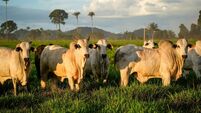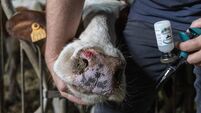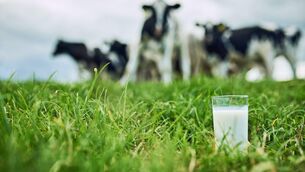Single farm payment uncertainty intensifies suckler-cow costs debate
THE debate about the cost of keeping a suckler cow is intense. This year, farmers have to weigh that cost against the uncertainty of the single farm payment on which they are so dependent, and fears of another winter-fodder crisis.
They are adding up the extra costs of having bought additional fodder over the past year, and increased mortality costs in a hard year for herds.
Usually, the price of weanlings in the autumn dictates whether or not they break even; this year, it dictates how much they lose.
One effect of the fodder crisis is reduced beef-cow numbers, and many suckler farmers are contemplating reducing cow numbers further, or leaving the enterprise.
Teagasc data shows a considerable variation in the cost of keeping a suckler cow, depending on the farmer’s efficiency. Variable costs for a suckler cow and a calf, to the weanling stage, can vary from €400 to €550.
Add fixed costs of €350 to €450 per cow.
A discussion group in the Teagasc-Irish Farmers’ Journal Better Farm beef programme, led by advisor Adam Woods, explored the cost of keeping a suckler cow, and weanling, to ten months.
The average cost was €741 (see table below).
Calculations were standardised from October to October, to include a full winter-housing period and keeping a spring-born calf to weaning.
Feeding the cow was the costliest item, assuming 8.4 tonnes of silage for a six-month winter, at €30 per tonne — bringing winter forage cost to €252.
Concentrates, at 2kg per day for 50 days after calving (€300/tonne for a 16% protein ration) and grazing, are the other components in feed costs of €438.
Veterinary costs include scour vaccine for the half of the herd calving indoors, dry-cow minerals fed for ten weeks before calving, at 100 grams/day, and caesarean sections (see figure 2).
The stock-bull cost was calculated on a per-calf and per-cow basis.
For example, a stock bull purchased for €3,000 to breed a 20-cow herd will produce 80 calves (in theory) over four years.
He costs €3,800, at €500 for annual maintenance, minus cull value.
This is €47.50 per calf. If the bull is kept for longer, the cost per calf is lower.
Replacement costs are included, at €60 per cow.
For example, four cows are replaced every year in a 20-cow herd with a 20% replacement rate.
Cull value is estimated at €1,200, an in-calf heifer costs €1,500, so €300 is the net replacement cost. This works out at €60 per cow in a 20-cow herd.
Weanling costs include grazing, pneumonia vaccine, and concentrate creep-feeding of 2kg/day for eight weeks.
Sundry costs are made up of straw, at €20 per cow; scanning and foot-paring, at €4 and €2, respectively.
Slurry-spreading is included, at €25 per cow (based on the amount a cow produces and the contractor’s spreading fee).
The group estimated fixed costs (insurance, depreciation etc) at up to €20/month.
Woods says “if the herd is autumn-calving, some farmers vaccinate more, which leads to higher costs”.
The variation in cost-per-cow ranged from €600 to €900, and, says Woods, soil type was the main cause of this variation.
Wetter soils lead to increased feed costs, due to earlier housing and a later grazing start.
What effect will the fodder crisis have on the cost of keeping a cow? “This year, the cost is likely to be closer to €900/cow due to the extra few months inside,” Woods says. Suckler farmers will do well this year if they cover their costs.
The discussion group hasn’t yet explored profitability, or ways to reduce costs.
It’s not easy to reduce costs per cow dramatically, because cow condition must be maintained.
Reducing feed costs in a big way would not be the best approach.
Woods says that his focus will be on increased efficiency, having better quality cows, and reducing the housing period.
Paul Crossan, of Teagasc Grange, says that feed costs can make up 70% of variable cost. He says the best way to reduce costs is to extend the grazing season. Increasing output per cow is also a way of distributing costs; having fewer empty cows will further reduce costs.
Are suckler farmers making any profit?
Dr Edward O’Riordan, enterprise leader at the Teagasc animal and grassland innovation centre, at Grange, says that suckler farmers are not making money without direct payments.
I also spoke to Thia Hennessy, of Teagasc, who says that the average income of a suckler farmer was €11,743 in 2012, down 8% from 2011. She says that without direct payments, suckler farmers are loss-making.
Thia says that cattle-rearing enterprises have the lowest-per-hectare income of all farm enterprises, averaging just €326. However, there are some exceptions — the top third of farmers averages €552/ha, while the bottom third averages €103.
Crossan says breeding higher-merit animals will lead to heavier weanlings. Five-star bulls, or AI, are long-term methods of achieving better weanlings, and, hopefully, more profit. “Medium-term steps to increase weanling weight include better milking cows, better pasture-management, meal feeding at weaning, and better animal health, that is, vaccines.”
The phase-one aim of the Better Farm programme was to achieve a gross margin of €1,000/ha.
The focus was on efficiently producing more liveweight.
Increased output was targeted through increased stocking rate, improved breeding performance, improved individual animal performance, and regular budgeting to optimise the sale price.
Grassland-management was a key factor. Growing more grass through reseeding, fertiliser and better slurry use are important steps.
All of these steps have led to a gross margin increase of 118%. The conclusion from phase one of the programme is that with a targeted and focused approach, farmers can make significant gains in output and gross margin.









